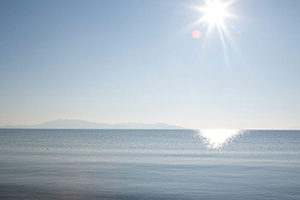Giannutri Island: where it is, the beaches and how to get there

Giannutri, a fascinating island in the Tuscan Archipelago, boasts an exclusive wilderness, accessible by ferry from Porto Santo Stefano. Predominantly pedestrian, it offers tranquillity and unspoilt places, with the Tuscan Archipelago National Park protecting much of the island, limiting free exploration to specific trails. Attractions include the easily accessible beaches and the Roman remains of Villa Domizia. To enter the island, regulations are necessary, requiring the purchase of an access ticket, and the exploration of certain areas requires the presence of an accompanying person. The island, which is a perfect destination for a spring visit, can be reached by a twice-weekly ferry service.
Giannutri and its coves
Accessible by ferry from Porto Santo Stefano, it boasts only about thirty permanent residents, thus reserving its wild beauty for a select few. Being predominantly pedestrian, Giannutri offers unspoilt and peaceful spaces, with short distances - less than 3 km separate Punta Secca, to the north, from Punta del Capel Rosso, to the south. In the centre of the island, on the eastern side, are Spalmatoio-Ischiaiola, where the ferries dock, and a modest concentration of dwellings. To effectively protect its natural heritage, a large part of Giannutri is under the protection of the Tuscan Archipelago National Park. This limits free exploration, allowing access only along the path that connects the two main inlets, cala Maestra and cala Spalmatoio, where it is nevertheless possible to bathe without limits. To discover the other areas of the island, it is necessary to use an authorised tourist guide, while some parts of the coast are protected areas, forbidden both by land and sea.
Among Giannutri's pearls, its beaches stand out: cala Maestra and cala Spalmatoio, both easily accessible. Other coves can be reached with the help of a guide or by sea.
Cala dello Spalmatoio, the ferry's arrival point, is adorned with many of the island's houses. This deep cove, with its rocky shoreline, offers crystal-clear waters and fascinating shades of blue. Although it is the most convenient to reach and close to the town, it is also the most crowded.
Cala Maestra
Situated on the opposite side of Cala Spalmatoio, and accessible on foot via an easy path less than a kilometre long, is Cala Maestra, the second of Giannutri's beaches open to the public. This place offers the possibility of stretching out on its small beach composed of sand and pebbles, while one end features a concrete platform ideal for sunbathing, embraced by the surrounding rocks.
Cala Schiavone, or Cala dello Schiavo
It forms a large part of the eastern coast of Giannutri, located south of Cala Spalmatoio. Access to this area is only possible by sea, and it has no beaches: the coastline is in fact characterised exclusively by rocks, making entry into the water particularly challenging. It is advisable to anchor a short distance from the coast to enjoy the scenery.
Cala Volo by Night
Cala Volo di Notte is located just below Cala Schiavone, in a particularly quiet and peaceful area bathed by a deep blue sea. The route to reach it on foot from cala Spalmatoio requires a hike of about 40 minutes along well-marked paths. Entering the water is arduous because of the sheer cliffs above the sea, but even simply standing at the top to enjoy the magnificent panorama is a very rewarding experience.
Roman Villa of Giannutri
In the heart of Giannutri, a small island, the only significant cultural point of interest is a series of Roman remains: the ancient harbour at cala Spalmatoio and a historic villa near cala Maestra. The latter, known as Villa Domizia, was built by the Domizi Enobarbi family, who owned the island in Roman times. This structure boasted a spectacular sea view and extended over an area of no less than 5 hectares. It even had a terrace with direct access to the sea via a flight of steps. Archaeological excavations in the previous century revealed the villa's floors, embellished with beautiful marble and mosaics in shades of black and white. Inside, the Roman villa of Giannutri was divided into several areas, respectively dedicated to the imperial family, the slaves and even the baths. This Roman residence, part of a complex of villas stretching as far as Argentario and the island of Giglio, can only be visited in the company of one of the park's guides, with a maximum limit of 75 visitors per day.
Regulated access to the island of Giannutri
Giannutri is part of the Tuscan Archipelago National Park and much of its territory is a protected area. Consequently, it is not permitted to move freely on the island. It is necessary to purchase an entrance ticket, at a cost of €4 per day, valid all year round, except for children under 12, school groups, persons with disabilities and workers on the island, as well as residents, property owners and tenants, of course. Tickets can be purchased together with the ferry ticket in Porto Santo Stefano, at the Pro Loco of Giglio Island or online at the park's website.
Once on the island, some areas are freely accessible, while others can only be visited with a guide. The areas that are freely accessible include the entire route from Cala Maestra to Cala Spalmatoio, a one-kilometre stretch that crosses the island from west to east starting directly from the harbour. Both coves can be visited without restriction.
Other areas of the island of Giannutri can only be visited with a guide, for reasons of environmental protection and safety. These include the entire network of paths, which stretches over 8 kilometres, with the exception of the free stretch between Cala Maestra and Cala Spalmatoio. Residents of the island, property owners and those staying in rented accommodation can move about freely without being accompanied by a guide.
The coast of the island of Giannutri is also regulated: there is a free zone, corresponding to Cala Maestra and Cala Spalmatoio, while the rest of the island is divided into a Zone 1, or Zone A, which is an integral reserve where access, navigation, fishing and diving are prohibited, and a Zone 2 called the Oriented Nature Reserve, where fishing is regulated by the Park Authority and boat mooring is permitted.
Zone 1 (or Zone A) includes the north-eastern section, with Cala dello Scoglio and the right-hand side of Punta Secca, a stretch of coast north of Cala Maestra, and the entire southern part of the island, including Punta del Calettino, Cala Brigantina and Punta del Capel Rosso. Zone 2 (or Zone B), on the other hand, includes a section of the north coast of Giannutri, between two Zone 1s, and a section of the west coast where Cala Ischiaiola is located.
When to visit the island of Giannutri
The island of Giannutri is a typical summer destination, while in winter there is not much to do. It is highly recommended to visit during late spring, when it is pleasant to walk along the many paths on the island, even if it is not possible to use the sea for swimming. It is important to remember that out of season, virtually all tourist services, including bars and restaurants, are closed.
Map of Giannutri Island
How to get to the island of Giannutri
The island of Giannutri can be reached by ferry from Porto Santo Stefano, located on the Argentario promontory. The service is run by the Maregiglio company via the motor vessel Costa d'Argento, with a capacity of 350 people; ferries leave on Wednesdays and Saturdays throughout the year. The crossing takes about an hour. It is important to note that it is not possible to transport vehicles, unless you are a resident or travel for work. If you are not in these categories, you will have to leave your car in one of the car parks in Porto Santo Stefano, which are also present near the port. The ferry ticket for Giannutri can be bought at the ferry ticket office in Porto Santo Stefano. You will easily find it in front of the harbour. A safer solution is to book online well in advance using the platform provided by the official Maregiglio website.
Where the island of Giannutri is located
Giannutri, the southernmost ornament of the Tuscan Archipelago located in the county of Grosseto, is a fascinating fragment hidden in the deep Tyrrhenian Sea.




























